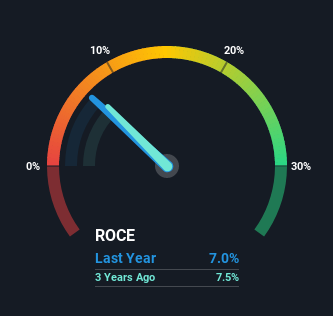- Italy
- /
- Healthcare Services
- /
- BIT:HI
Investors Could Be Concerned With Health Italia's (BIT:HI) Returns On Capital

Did you know there are some financial metrics that can provide clues of a potential multi-bagger? Typically, we'll want to notice a trend of growing return on capital employed (ROCE) and alongside that, an expanding base of capital employed. Ultimately, this demonstrates that it's a business that is reinvesting profits at increasing rates of return. In light of that, when we looked at Health Italia (BIT:HI) and its ROCE trend, we weren't exactly thrilled.
Understanding Return On Capital Employed (ROCE)
For those that aren't sure what ROCE is, it measures the amount of pre-tax profits a company can generate from the capital employed in its business. The formula for this calculation on Health Italia is:
Return on Capital Employed = Earnings Before Interest and Tax (EBIT) ÷ (Total Assets - Current Liabilities)
0.07 = €3.3m ÷ (€62m - €16m) (Based on the trailing twelve months to June 2021).
Therefore, Health Italia has an ROCE of 7.0%. Even though it's in line with the industry average of 7.0%, it's still a low return by itself.
See our latest analysis for Health Italia

Historical performance is a great place to start when researching a stock so above you can see the gauge for Health Italia's ROCE against it's prior returns. If you want to delve into the historical earnings, revenue and cash flow of Health Italia, check out these free graphs here.
What Can We Tell From Health Italia's ROCE Trend?
When we looked at the ROCE trend at Health Italia, we didn't gain much confidence. Over the last five years, returns on capital have decreased to 7.0% from 31% five years ago. Although, given both revenue and the amount of assets employed in the business have increased, it could suggest the company is investing in growth, and the extra capital has led to a short-term reduction in ROCE. If these investments prove successful, this can bode very well for long term stock performance.
On a side note, Health Italia has done well to pay down its current liabilities to 26% of total assets. That could partly explain why the ROCE has dropped. Effectively this means their suppliers or short-term creditors are funding less of the business, which reduces some elements of risk. Some would claim this reduces the business' efficiency at generating ROCE since it is now funding more of the operations with its own money.
The Bottom Line
While returns have fallen for Health Italia in recent times, we're encouraged to see that sales are growing and that the business is reinvesting in its operations. And there could be an opportunity here if other metrics look good too, because the stock has declined 52% in the last five years. So we think it'd be worthwhile to look further into this stock given the trends look encouraging.
If you want to continue researching Health Italia, you might be interested to know about the 2 warning signs that our analysis has discovered.
While Health Italia may not currently earn the highest returns, we've compiled a list of companies that currently earn more than 25% return on equity. Check out this free list here.
Valuation is complex, but we're here to simplify it.
Discover if Health Italia might be undervalued or overvalued with our detailed analysis, featuring fair value estimates, potential risks, dividends, insider trades, and its financial condition.
Access Free AnalysisHave feedback on this article? Concerned about the content? Get in touch with us directly. Alternatively, email editorial-team (at) simplywallst.com.
This article by Simply Wall St is general in nature. We provide commentary based on historical data and analyst forecasts only using an unbiased methodology and our articles are not intended to be financial advice. It does not constitute a recommendation to buy or sell any stock, and does not take account of your objectives, or your financial situation. We aim to bring you long-term focused analysis driven by fundamental data. Note that our analysis may not factor in the latest price-sensitive company announcements or qualitative material. Simply Wall St has no position in any stocks mentioned.
About BIT:HI
Health Italia
Health Italia S.p.A. promotes supplementary health plans and solutions for the prevention and well-being of the families, SMEs, corporates, and public administration in Italy.
Flawless balance sheet low.

